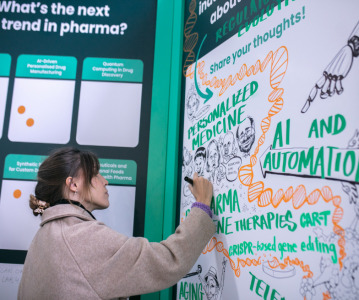5 Things We Learned from the CPHI North America Content Program

The CPHI North America exhibition is taking place in-person this week in Philadelphia from 10-12 August. Here we take a look at key learnings from the past two weeks of expert-led content, available to all attendees as part of the hybrid event experience.
This year’s agenda celebrates innovation, progress and diversity in the US pharma market, and is available to view within the hybrid event platform until 20 August.
Here are five key takeaways from the content program:
1. COVID-19 Vaccine Achievements Accelerate Innovation in mRNA Therapeutics
As part of his presentation on ‘The Lasting Impact of COVID-19 on Drug Development’, Anil Kane, Executive Director at Thermo Fisher Scientific points to how the success of mRNA vaccine development has spurred on the use of mRNA therapeutics for other indications. Kane says there are 171 mRNA drugs in development currently, and though the vast majority of these are preclinical, the technology is now being used for developing treatments for several different types of cancers, infectious diseases and COVID-19.
2. The Realities of Reshoring Manufacturing
Led by Wayne Weiner, Principal of PharmaTech solutions, panel members from Pharmatech Associates, Flamma US and AAM debate ‘The Real Cost of Bringing Manufacturing Home’, after many months of increased scrutiny on the reliance of China and India for the manufacture and production of APIs and essential medicines for US consumption. Bikash Chatterjee, CEO of Pharmatech Associates, believes that weaknesses in the supply chain highlighted by the pandemic do raise the question whether “other initiatives, such as near-shoring, or a combination of off-shoring and on-shoring may provide greater resiliency’ going forward.”
Kenneth Drew, VP of Flamma US raises the point that there have been issues with consistent supply of raw materials such as solvents, acids and bases, which pre-date the COVID-19 pandemic, so “the idea of onshoring and having everything made in the US, is a bit of a fallacy”.
3. Capacity is Needed to Manage Future Pandemics and Healthcare Emergencies
In his presentation, ‘COVID-19, the Future of Healthcare and Pandemics’, Scott Gottlieb, Former FDA Commissioner says one of the key challenges in managing the coronavirus pandemic was not having “the capacities we thought we had and that we certainty needed” in order to scale up manufacturing of antibody candidates and vaccines.
Gottlieb shares the example of Amgen, who guaranteed the Federal Government that there would never be an interruption in their supply of Neupogen, a drug manufactured at their ‘super hardened’ Puerto Rico facility and used to boost white blood cell counts after radiation poisoning. The drug is currently used in patients undergoing chemotherapy but would also be essential in the event of a nuclear incident.
This preparedness meant that when Hurricane Maria hit Puerto Rico in September 2017, Amgen were one of the few manufacturers able to stay online and maintain production.
Gottlieb believes what is needed to help manage future pandemics is strategic investments into facilities to build a system of capacity – particularly in pan-respiratory therapeutics.
4. Diversification and addition of capabilities key to CDMO success as end markets grow
CDMOs need to diversify and expand their capabilities to take full advantage of strong growth in prominent end markets such as small molecule, monoclonal antibodies and cell and gene therapy.
Speaking at the session M&A Climate & Current Market Dynamics, David Windley, Managing Director, Jefferies Healthcare Equity Research identifies these three main end markets as presenting the best opportunities for CDMOs but warns that they cannot “stand still” as they continue to evolve.
“A CDMO can focus in any one of those areas, some of the biggest ones are spanning across a multiple of those areas, but I don’t think it’s really a viable strategy anymore for the long term for a service provider to be a one-trick pony in small molecules,” he tells the conference. “I think you’ve got to be API and drug product, or if you’re only in drug product, you’ve got to be multi-formulation capability.”
5. Transformative technologies and COVID-19 opportunities are driving investment in the life sciences outsourcing sector
In the webinar, US Pharmaceutical Market Outlook 2021: CDMO Deal Making in a Pandemic and Beyond, James Gale, Managing Director at private equity firm, Signet Healthcare Partners, tells the audience that despite an initial economic slowdown in 2020 due to pandemic-linked uncertainty, “as a lot of money was pushed into the economy by the fed, the capital markets have gone up dramatically creating a huge inflow of cash to the life sciences industry and supporting R&D activities.”
Gale says the breakthrough achievement of the COVID vaccines by Pfizer and Moderna has spawned an entirely new platform for vaccine development.
“Our belief is that there are exciting new technologies that are coming along that are transforming the practice of medicine, principally things like immunotherapy, cell and gene therapy, new vaccine forms that are increasingly creating new opportunities for treating patients,” he adds. “These are the kind of technologies that have really engendered a lot of enthusiasm for growth and much of that is being outsourced.”
To gain access to all of these sessions as well as all other CPHI North America online content, you can register for a pass here.
Related News
-
News US FDA adds haemodialysis bloodlines to devices shortage list
On March 14, 2025, the US FDA published an open letter to healthcare providers citing continuing supply disruptions of haemodialysis bloodlines, an essential component of dialysis machines. -
News Vertex Pharmaceuticals stock jumps as FDA approves non-opioid painkiller
UK-based Vertex Pharmaceuticals saw their stock shares soar as the US FDA signed off on the non-opioid painkiller Journavx, also known as suzetrigine, for patients with moderate to severe acute pain, caused by surgery, accidents, or injuries. -
News Lessons from CPHI Milan 2024: Sunny Intervals for Pharma Manufacturing?
As the 2024 CPHI conference wrapped up in Milan, we caught up with L.E.K. Consulting – a global strategy consulting firm with deep expertise in pharma manufacturing – to discuss evolving market perspectives and business outlook. -
News US BIOSECURE Act passed by US House of Representatives
The controversial act, which has already impacted several foreign companies operating in the US, was passed by the House of Representatives on September 9, 2024. It is now headed for the US Senate before it can be signed into law by President Joe Biden... -
News Pharma Supply Chain People Moves
The latest appointments, promotions, and structural changes across the pharmaceutical supply chain. -
News Drug prices agreed upon as part of the US Inflation Reduction Act
The Inflation Reduction Act brought into constitution by the Biden administation in 2022, which proposed a drug price negotiation between the government and pharmaceutical companies, has reached it's first agreement. -
News BIOSECURE Act continues to loom over Chinese pharma manufacturers
With the US BIOSECURE Act on its way to passing into legislation, Chinese companies are facing declining revenues within the first half of 2024 as US pharmaceutical and healthcare companies pull their businesses from the country. -
News Ophthalmologic drug product Eylea faces biosimilar threats after FDA approvals
Regeneron Pharmaceutical’s blockbuster ophthalmology drug Eylea is facing biosimilar competition as the US FDA approves Biocon’s Yesafili and Samsung Bioepis/Biogen’s Opuviz.
Recently Visited
Position your company at the heart of the global Pharma industry with a CPHI Online membership
-
Your products and solutions visible to thousands of visitors within the largest Pharma marketplace
-
Generate high-quality, engaged leads for your business, all year round
-
Promote your business as the industry’s thought-leader by hosting your reports, brochures and videos within your profile
-
Your company’s profile boosted at all participating CPHI events
-
An easy-to-use platform with a detailed dashboard showing your leads and performance






.png)
.png)